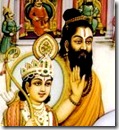 “Some
were excited, but the bow was immovable, like the word of a saint.
Looking at the bow, their strength and intelligence were forcefully
stolen, like with King Nahusha.” (Janaki Mangala, Chand 11.2)
“Some
were excited, but the bow was immovable, like the word of a saint.
Looking at the bow, their strength and intelligence were forcefully
stolen, like with King Nahusha.” (Janaki Mangala, Chand 11.2)
eka karahiṃ dāpa na cāpa sajjana bacana jimi ṭāreṃ ṭarai |
nṛpa nahuṣa jyoṃ saba keṃ bilokata buddhi bala barabasa harai ||
nṛpa nahuṣa jyoṃ saba keṃ bilokata buddhi bala barabasa harai ||
Goswami
Tulsidas here makes a few references to Vedic history to describe what
happened to the rival princes as they tried to lift the famous bow of
Lord Shiva. The setting was a kingdom hosting an event with thousands in
attendance. The main attraction, the final act on the bill if you will,
was the lifting of the bow. Whoever could do it first would win. The
fight would be declared over as soon as that bow went in a prince’s hand
and was raised to the sky. As destiny’s will is impossible to subvert,
on this day only one person was set to win, someone who has never lost
anything in His life.
Do we
know of anyone who has never lost? Famous political figures may have won
the big election when they were on the ballot, but they definitely lost
something prior to that. No one goes completely undefeated. Death is
the greatest champion in this regard, as it defeats every single person,
regardless of the effort they make to send it back from where it came.
To
say that God is undefeated seems a bit obvious. “Oh sure, go the God
route. You can just say that about anything. ‘I will never win this.
Only God could do this. It is hopeless for me. No one but God could
succeed in these trying circumstances.’” The Vedas give more than just
an abstract or utopian idea of God. There are concrete details provided
which are easy to remember, provided that one wants to remember them.
And
why wouldn’t we want to remember someone who is undefeated? To aid in
the remembrance we get God’s name of Achyuta. Just saying the name
“Achyuta” over and over again brings God to the mind, allowing us to
remember that He is undefeated. If that remembrance isn’t giving enough
pleasure, go back to an incident that proved that He is the strongest
person in the world. For such an incident to take place, the undefeated
figure known as God must have a form that is visible to the eyes.
There
are debates among transcendentalists as to whether God is with form or
without, whether He is a personality or just an energy. On a higher
level, the arguments are a waste of time because we only think in terms
of form and formlessness because of our limited abilities. On a cloudy
day we say that the sun is not out, but the sun hasn’t gone anywhere. We
say that a person is gone after they die, but their soul still exists.
They are still alive, though we can’t see them.
To
make an entity distinct, we refer to them as a person. A person
possesses features but a person is also flawed. Therefore we think God
can’t be a person because that would mean He’s flawed. He must also be
without form because we can’t see Him. Both of these are indeed not the
case; His personality and form are different than how we know
personalities and forms. He is the Supreme Person, and His attributes
are divine. He can lift an extremely heavy bow while in the visible
manifestation of a young prince.
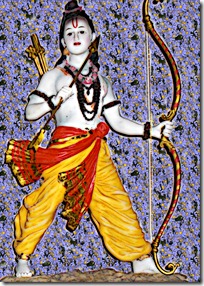 Before
that victory took place, other princes tried their hand. King Janaka
hosted this contest to find a groom for the bride, his daughter Sita
Devi. What better way to find a good protector than to hold a contest
relating to strength? But this bow was originally Shiva’s, and Sita is
eternally Rama’s. Rama is the Supreme Lord in His incarnation as a
warrior prince. Rama appears before the eyes, but He is not an ordinary
person. He possesses the attributes of beauty, wealth, strength, fame,
wisdom and renunciation to the fullest degree and at the same time.
Before
that victory took place, other princes tried their hand. King Janaka
hosted this contest to find a groom for the bride, his daughter Sita
Devi. What better way to find a good protector than to hold a contest
relating to strength? But this bow was originally Shiva’s, and Sita is
eternally Rama’s. Rama is the Supreme Lord in His incarnation as a
warrior prince. Rama appears before the eyes, but He is not an ordinary
person. He possesses the attributes of beauty, wealth, strength, fame,
wisdom and renunciation to the fullest degree and at the same time.In the above referenced verse from the Janaki Mangala, Goswami Tulsidas continues his description of the kings who tried to win the contest. Prior to this, some just stared at the bow and walked away, making an excuse. They were like monkeys looking at a coconut, not trying to open it because they were too afraid of the shame of losing. The kings mentioned above were so excited that they actually tried to lift the bow. But it is said that the bow was immovable, like the word of a saint.
A saint in the Vedic tradition is known as a brahmana, which can be likened to a priest. A brahmana lives by austerity and penance, and through their good deeds they acquire tremendous spiritual merits. As a result, when they say something, it must come to be. For instance, if they curse someone, the results of the curse must manifest. If they are supplicated after the fact, they can proclaim something else which will also come to be, but they will never take back their word of the original curse. This is a power granted to brahmanas by the Supreme Lord, who holds His devotees in very high esteem.
It is also said that by looking at the bow, the strength and intelligence of the kings were forcefully stolen, like with what happened to King Nahusha. Nahusha was a famous king during ancient times, and through his pious deeds he ascended to the heavenly realm. The three worlds are the earth, the heavenly planets, and the hellish planets. As they are all part of the material world, residence is not permanent for the wandering soul. You go to heaven if you are good in this life, but you don’t stay there forever. Similarly, being condemned to hell doesn’t mean that you are stuck there without any hope.
King
Nahusha was in heaven, but while there he had lusty desires towards the
wife of King Indra. Indra is the king of heaven and he cursed Nahusha
to fall from heaven and be born as a snake for his impious thoughts.
Material life is thus very tenuous; there is no certainty for anyone.
These kings were previously considered to be very powerful and
intelligent, but since this bow was destined to be lifted by Rama, they
seemingly lost all their strength just by looking at it.
Fortunately,
there is one discipline that is above the material nature, that brings
permanent results in a permanent realm. Devotional service, also known
as bhakti-yoga, is the soul’s eternal occupation, and one of its primary
methods of implementation is hearing. Just hearing about Rama’s
eventual victory in the contest, and how all the other kings were bested
by the bow He was to lift, brings the consciousness closer to the
transcendental realm. While the curse of a saint cannot be reversed and
accumulated merits can vanish with a single transgression, know that
through loving God spiritual strength increases in a manner that is
irreversible. The undefeated Shri Rama makes sure of it.
In Closing:
Through piety Nahusha to heaven went,
With lusty desires back to earth sent.
Once a curse upon you a saint does make,
Can’t go back, their word never to break.
Comparisons the bow contest help to describe,
Excited kings failed though with effort they tried.
Strength with one look stolen, move the bow would not,
Rama destined to win, beautiful Sita as wife He got.
 “Unable to get the desired result, some made an excuse and stayed where they were, while others went to see the bow. Like a monkey examining a coconut, they each sat back down with their heads hanging down.” (Janaki Mangala, Chand 11.1)
“Unable to get the desired result, some made an excuse and stayed where they were, while others went to see the bow. Like a monkey examining a coconut, they each sat back down with their heads hanging down.” (Janaki Mangala, Chand 11.1)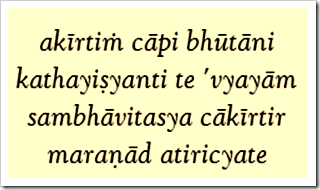 “People will always speak of your infamy, and for one who has been honored, dishonor is worse than death.” (Lord Krishna, Bhagavad-gita, 2.34)
“People will always speak of your infamy, and for one who has been honored, dishonor is worse than death.” (Lord Krishna, Bhagavad-gita, 2.34)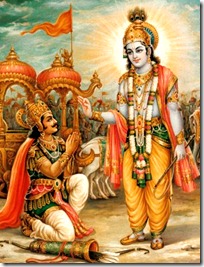 In the Bhagavad-gita, Lord Krishna tells Arjuna that for a celebrated warrior, dishonor is worse than death. This is because they were previously honored. They were known for some reason or another. Through dishonor, they tarnish their reputation. The eager journalists pay close attention to scandal for this very reason. If they can take down a celebrated figure through reporting their flaws, their story will be very popular. The dishonor will draw much attention because it is focused on someone who was previously honored. Dishonor to someone who was never honored isn’t as important.
In the Bhagavad-gita, Lord Krishna tells Arjuna that for a celebrated warrior, dishonor is worse than death. This is because they were previously honored. They were known for some reason or another. Through dishonor, they tarnish their reputation. The eager journalists pay close attention to scandal for this very reason. If they can take down a celebrated figure through reporting their flaws, their story will be very popular. The dishonor will draw much attention because it is focused on someone who was previously honored. Dishonor to someone who was never honored isn’t as important.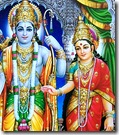 “You
can see the love they have for each other, which they try to keep
secret. Knowingly they erect a collection of stable pillars made of
goodness within their hearts.” (Janaki Mangala, 85)
“You
can see the love they have for each other, which they try to keep
secret. Knowingly they erect a collection of stable pillars made of
goodness within their hearts.” (Janaki Mangala, 85)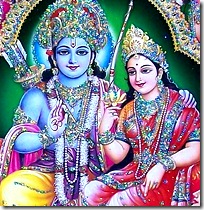 One
way to foster that goodness on the inside, to erect pillars of good
qualities within the heart, so much so that it looks like you have a
neighborhood full of sturdy buildings made of goodness, is to hear about
God and His pastimes. One of His most famous pastimes is His lifting of
the illustrious bow belonging to Lord Shiva. This occurred in the
kingdom of Janakpur, where a contest was taking place. At the time the
Supreme Lord was there in His incarnation of Shri Ramachandra, the
eldest son of King Dasharatha. Lord Rama is God based on His qualities,
which are described in the Vedic texts. He is not a pseudo-incarnation
created on a whim after the fact. His appearance and activities were
described before they took place by Maharishi Valmiki, a self-realized
soul, a paramahamsa in his own right.
One
way to foster that goodness on the inside, to erect pillars of good
qualities within the heart, so much so that it looks like you have a
neighborhood full of sturdy buildings made of goodness, is to hear about
God and His pastimes. One of His most famous pastimes is His lifting of
the illustrious bow belonging to Lord Shiva. This occurred in the
kingdom of Janakpur, where a contest was taking place. At the time the
Supreme Lord was there in His incarnation of Shri Ramachandra, the
eldest son of King Dasharatha. Lord Rama is God based on His qualities,
which are described in the Vedic texts. He is not a pseudo-incarnation
created on a whim after the fact. His appearance and activities were
described before they took place by Maharishi Valmiki, a self-realized
soul, a paramahamsa in his own right. Only
through knowing the self, which is completely spiritual, can you get
rid of envy, lust, greed, anger and all other negative emotions. To know
God is to know the self, for He is the Supreme Soul, or the Superself.
He is the origin of both matter and spirit, and so if you learn about
Him as best you can, you will know yourself too. And when you know
yourself, you will know others, and pretty soon you will see that we are
all in the same boat, trying to find our way to eternal happiness.
Only
through knowing the self, which is completely spiritual, can you get
rid of envy, lust, greed, anger and all other negative emotions. To know
God is to know the self, for He is the Supreme Soul, or the Superself.
He is the origin of both matter and spirit, and so if you learn about
Him as best you can, you will know yourself too. And when you know
yourself, you will know others, and pretty soon you will see that we are
all in the same boat, trying to find our way to eternal happiness.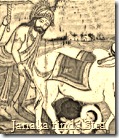 “She
arose from the surface of the earth when it was pierced by a
ploughshare. She was covered with auspicious dust from the field that
resembled the pollen from a lotus.” (Hanuman, Valmiki Ramayana, Sundara
Kand, 16.16)
“She
arose from the surface of the earth when it was pierced by a
ploughshare. She was covered with auspicious dust from the field that
resembled the pollen from a lotus.” (Hanuman, Valmiki Ramayana, Sundara
Kand, 16.16)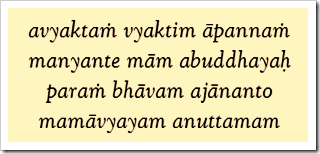 “Unintelligent
men, who know Me not, think that I have assumed this form and
personality. Due to their small knowledge, they do not know My higher
nature, which is changeless and supreme.” (Lord Krishna, Bhagavad-gita,
7.24)
“Unintelligent
men, who know Me not, think that I have assumed this form and
personality. Due to their small knowledge, they do not know My higher
nature, which is changeless and supreme.” (Lord Krishna, Bhagavad-gita,
7.24)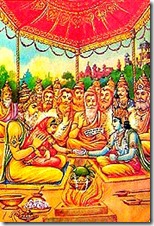 Not
surprisingly, that devotee welcomed Vishnu’s wife, Lakshmi Devi, into
his family when she appeared on earth to accompany her husband, who
appeared as Lord Rama from the Raghu dynasty. In the above referenced
verse from the Ramayana, Shri Hanuman mentions the unique circumstances
of Sita’s appearance. She arose from the earth as it was being pierced
by a ploughshare. As a pious king, Janaka was preparing for a sacrifice,
and wouldn’t you know it, the fruit of that religious act arrived
before the ceremony officially began. A beautiful baby was found in the
ground, and Janaka named her Sita because of where she came from. The
dust covering baby Sita resembled the pollen from a lotus flower.
Originally, Sita is Lakshmi, who is very fond of lotuses. Therefore it
wasn’t surprising that she would be covered by this kind of dirt when
she appeared in Tirahuta.
Not
surprisingly, that devotee welcomed Vishnu’s wife, Lakshmi Devi, into
his family when she appeared on earth to accompany her husband, who
appeared as Lord Rama from the Raghu dynasty. In the above referenced
verse from the Ramayana, Shri Hanuman mentions the unique circumstances
of Sita’s appearance. She arose from the earth as it was being pierced
by a ploughshare. As a pious king, Janaka was preparing for a sacrifice,
and wouldn’t you know it, the fruit of that religious act arrived
before the ceremony officially began. A beautiful baby was found in the
ground, and Janaka named her Sita because of where she came from. The
dust covering baby Sita resembled the pollen from a lotus flower.
Originally, Sita is Lakshmi, who is very fond of lotuses. Therefore it
wasn’t surprising that she would be covered by this kind of dirt when
she appeared in Tirahuta.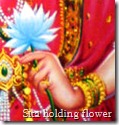 “This
is Sita, who is firmly dedicated to her husband and is the daughter of
the great soul Janaka, who is the King of Mithila and strictly adherent
to religious principles.” (Hanuman, Valmiki Ramayana, Sundara Kand,
16.15)
“This
is Sita, who is firmly dedicated to her husband and is the daughter of
the great soul Janaka, who is the King of Mithila and strictly adherent
to religious principles.” (Hanuman, Valmiki Ramayana, Sundara Kand,
16.15)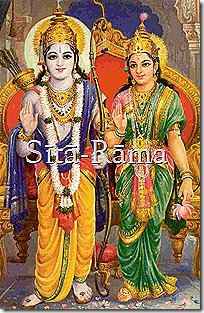 In
this verse from the Ramayana Shri Hanuman confirms to himself that he
has spotted Sita. Hanuman is in a grove of Ashoka trees inside of the
kingdom of Lanka, which was presided over at the time by the Rakshasa
king Ravana. Hanuman doesn’t say that he has found the material body or
the “Sita” within. He refers to Sita by her identifiable features, which
are perceivable and understandable to the sober person who has no
intention of twisting the truth to suit their personal needs.
In
this verse from the Ramayana Shri Hanuman confirms to himself that he
has spotted Sita. Hanuman is in a grove of Ashoka trees inside of the
kingdom of Lanka, which was presided over at the time by the Rakshasa
king Ravana. Hanuman doesn’t say that he has found the material body or
the “Sita” within. He refers to Sita by her identifiable features, which
are perceivable and understandable to the sober person who has no
intention of twisting the truth to suit their personal needs.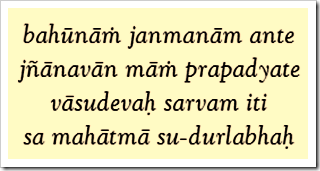 “After
many births and deaths, he who is actually in knowledge surrenders unto
Me, knowing Me to be the cause of all causes and all that is. Such a
great soul is very rare.” (Lord Krishna, Bhagavad-gita, 7.19)
“After
many births and deaths, he who is actually in knowledge surrenders unto
Me, knowing Me to be the cause of all causes and all that is. Such a
great soul is very rare.” (Lord Krishna, Bhagavad-gita, 7.19) “This divine lady’s mind is situated in His and His in hers. It is for this reason alone that she and that righteous-souled man are able to live for even a moment.” (Hanuman, Valmiki Ramayana, Sundara Kand, 15.52)
“This divine lady’s mind is situated in His and His in hers. It is for this reason alone that she and that righteous-souled man are able to live for even a moment.” (Hanuman, Valmiki Ramayana, Sundara Kand, 15.52)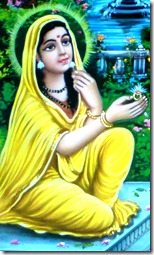 Hanuman also notes that Rama, who is a righteous soul, or dharma-atma, has His mind firmly fixed in Sita’s. This is a truth we are kindly reminded of in the Bhagavad-gita, the famous scripture of the Vedic tradition spoken by Shri Krishna Himself many years later. In that work the Lord says that the devotees are never lost to Him, since they see Him everywhere. It is not that He ignores the non-devotees, but if someone doesn’t want to connect with Him, the Lord will not force Himself upon them. This means that only in bhakti-yoga, divine connection in love, is there aid from the superior party. All other kinds of transcendentalism are thus more difficult because the burden for success is on the individual, who is known to be flawed based on the fact that they took birth from a womb. Any birth, whether in an animal or human species, indicates that in the previous existence there was a failure to think of God at the time of death.
Hanuman also notes that Rama, who is a righteous soul, or dharma-atma, has His mind firmly fixed in Sita’s. This is a truth we are kindly reminded of in the Bhagavad-gita, the famous scripture of the Vedic tradition spoken by Shri Krishna Himself many years later. In that work the Lord says that the devotees are never lost to Him, since they see Him everywhere. It is not that He ignores the non-devotees, but if someone doesn’t want to connect with Him, the Lord will not force Himself upon them. This means that only in bhakti-yoga, divine connection in love, is there aid from the superior party. All other kinds of transcendentalism are thus more difficult because the burden for success is on the individual, who is known to be flawed based on the fact that they took birth from a womb. Any birth, whether in an animal or human species, indicates that in the previous existence there was a failure to think of God at the time of death.
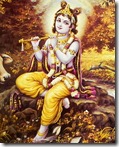 “Everyone is engaged in material sense gratification, but people have no plan for making an ultimate solution to their real problems, namely, birth, disease, old age and death. These four material miseries are called bhava-roga, or material diseases. They can be cured only by Krishna consciousness. Therefore Krishna consciousness is the greatest benediction for human society.” (Shrila Prabhupada, Chaitanya Charitamrita, Adi 3.97 Purport)
“Everyone is engaged in material sense gratification, but people have no plan for making an ultimate solution to their real problems, namely, birth, disease, old age and death. These four material miseries are called bhava-roga, or material diseases. They can be cured only by Krishna consciousness. Therefore Krishna consciousness is the greatest benediction for human society.” (Shrila Prabhupada, Chaitanya Charitamrita, Adi 3.97 Purport) Bhakti-yoga reaches into the depths of the soul and extracts the true potential for action. Within that enlivened state, the ancillary concerns are accounted for automatically. To use the previous example again, with an identified objective of a fit body, I automatically tweak my daily routine. I may or may not know how to eat properly in the beginning, but with trial and error and an evaluation of the results with respect to the final goal, I can decide which procedures work and which ones don’t.
Bhakti-yoga reaches into the depths of the soul and extracts the true potential for action. Within that enlivened state, the ancillary concerns are accounted for automatically. To use the previous example again, with an identified objective of a fit body, I automatically tweak my daily routine. I may or may not know how to eat properly in the beginning, but with trial and error and an evaluation of the results with respect to the final goal, I can decide which procedures work and which ones don’t. We must also incorporate the fact that the life of hedonism is not appealing to someone who knows the nature of the soul and how to connect with the reservoir of pleasure. From this fact alone we get a limitation to the atheist’s motto of “do whatever you want, whenever you want.” But when you flip things around, you see that bhakti-yoga brings happiness even to the atheist, in spite of their initial reluctance to practice it.
We must also incorporate the fact that the life of hedonism is not appealing to someone who knows the nature of the soul and how to connect with the reservoir of pleasure. From this fact alone we get a limitation to the atheist’s motto of “do whatever you want, whenever you want.” But when you flip things around, you see that bhakti-yoga brings happiness even to the atheist, in spite of their initial reluctance to practice it. For the serious yogi in bhakti, the chanting routine is extended to a fixed minimum number of daily recitations of the maha-mantra on a set of japa beads. There is also a prohibition on meat eating, gambling, intoxication and illicit sex. What is considered bitter in the beginning turns into sweet nectar, whereas with sense gratification in ignorance the situation is reversed. The person in bhakti feels the pleasure of connecting with God, which in turn makes them more anxious to continue that service going forward. The person who despises God or ignores His existence at least with bhakti finds a peaceful routine and a way to steer clear of activities that are so harmful. In this way both sets of participants benefit. As the devotee and staunch atheist represent the extreme opposite ends of the spectrum, every type of condition in between is accounted for as well.
For the serious yogi in bhakti, the chanting routine is extended to a fixed minimum number of daily recitations of the maha-mantra on a set of japa beads. There is also a prohibition on meat eating, gambling, intoxication and illicit sex. What is considered bitter in the beginning turns into sweet nectar, whereas with sense gratification in ignorance the situation is reversed. The person in bhakti feels the pleasure of connecting with God, which in turn makes them more anxious to continue that service going forward. The person who despises God or ignores His existence at least with bhakti finds a peaceful routine and a way to steer clear of activities that are so harmful. In this way both sets of participants benefit. As the devotee and staunch atheist represent the extreme opposite ends of the spectrum, every type of condition in between is accounted for as well.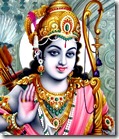 “Understanding that Rama’s beauty, patience, age and ancestry were completely perfect, the king remembered his own oath and thus started to lament.” (Janaki Mangala, 48)
“Understanding that Rama’s beauty, patience, age and ancestry were completely perfect, the king remembered his own oath and thus started to lament.” (Janaki Mangala, 48) Dharma was important to Janaka. A king who doesn’t follow dharma isn’t much of a king. To be a good protector, one must be able to govern the citizens in such a way that they all stay happy, regardless of their situation. The only way to make this a reality is to follow the established law codes of scripture, which are presented nicely in the Vedas. If you go on your own whim, others will then have license to do so as well. As desires for personal satisfaction are sure to clash, the result is stiff competition. Man’s actions are then guided by the motto of “win at all costs”. In fact, this is the situation at present, where government leaders operate on the mentality that whoever will provide them the most votes should gain the most favor from government. Never mind that every person is equally a citizen and that the leader should be impartial. Send money to a candidate and you will get a seat at the table of power should they get elected.
Dharma was important to Janaka. A king who doesn’t follow dharma isn’t much of a king. To be a good protector, one must be able to govern the citizens in such a way that they all stay happy, regardless of their situation. The only way to make this a reality is to follow the established law codes of scripture, which are presented nicely in the Vedas. If you go on your own whim, others will then have license to do so as well. As desires for personal satisfaction are sure to clash, the result is stiff competition. Man’s actions are then guided by the motto of “win at all costs”. In fact, this is the situation at present, where government leaders operate on the mentality that whoever will provide them the most votes should gain the most favor from government. Never mind that every person is equally a citizen and that the leader should be impartial. Send money to a candidate and you will get a seat at the table of power should they get elected.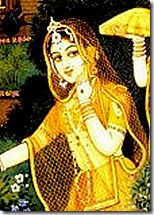 There was another side to this contest that Janaka didn’t immediately realize. If someone should attempt to lift the bow and fail, they would be automatically disqualified from marrying Sita. The focus was on finding someone who could lift the bow, which meant the elimination factor was ignored. But what if someone showed up to Janaka’s city who was perfect in every way? What if their beauty was unmatched and their ancestry sparkling? What if they had tremendous patience and dedication to chivalry? What if they were quite strong and had a charming visage? Then what could the king do?
There was another side to this contest that Janaka didn’t immediately realize. If someone should attempt to lift the bow and fail, they would be automatically disqualified from marrying Sita. The focus was on finding someone who could lift the bow, which meant the elimination factor was ignored. But what if someone showed up to Janaka’s city who was perfect in every way? What if their beauty was unmatched and their ancestry sparkling? What if they had tremendous patience and dedication to chivalry? What if they were quite strong and had a charming visage? Then what could the king do? Rama was the Supreme Lord appearing on earth in the guise of a human being. The purpose given for His descents is to annihilate the miscreants and defend the pious, but in reality there needn’t be a specific purpose. Whatever makes the Supreme Lord happy, He does. He finally killed Tataka, and Vishvamitra was pleased with Him. He then gave both Rama and Lakshmana secret mantras to be used in fighting.
Rama was the Supreme Lord appearing on earth in the guise of a human being. The purpose given for His descents is to annihilate the miscreants and defend the pious, but in reality there needn’t be a specific purpose. Whatever makes the Supreme Lord happy, He does. He finally killed Tataka, and Vishvamitra was pleased with Him. He then gave both Rama and Lakshmana secret mantras to be used in fighting.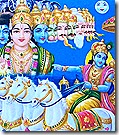 “This virat-rupa of the Lord was especially manifested, not for the benefit of Arjuna, but for that unintelligent class of men who accept anyone and everyone as an incarnation of the Lord and so mislead the general mass of people. For them, the indication is that one should ask the cheap incarnation to exhibit his virat-rupa and thus be established as an incarnation.” (Shrila Prabhupada, Shrimad Bhagavatam, 2.1.24 Purport)
“This virat-rupa of the Lord was especially manifested, not for the benefit of Arjuna, but for that unintelligent class of men who accept anyone and everyone as an incarnation of the Lord and so mislead the general mass of people. For them, the indication is that one should ask the cheap incarnation to exhibit his virat-rupa and thus be established as an incarnation.” (Shrila Prabhupada, Shrimad Bhagavatam, 2.1.24 Purport)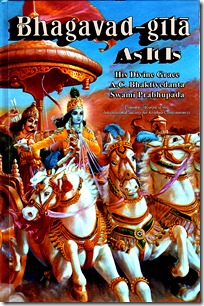 From the Bhagavad-gita you get lessons on duty, morality, virtue, sin, vice, lust, greed, birth and death, the true identity of the individual, and most importantly what the individual’s relationship to the higher being is. Despite the profound wisdom found in the verses of this sacred work, the speaker, the supreme teacher, still didn’t want others to mistake Him to be a hack mental speculator. The truths passed on to Arjuna and future generations were not mentally concocted, nor did they arrive as a revelation to the speaker. He knew what He was talking about because He is the origin of knowledge; He is the smartest person based on His inherent characteristics.
From the Bhagavad-gita you get lessons on duty, morality, virtue, sin, vice, lust, greed, birth and death, the true identity of the individual, and most importantly what the individual’s relationship to the higher being is. Despite the profound wisdom found in the verses of this sacred work, the speaker, the supreme teacher, still didn’t want others to mistake Him to be a hack mental speculator. The truths passed on to Arjuna and future generations were not mentally concocted, nor did they arrive as a revelation to the speaker. He knew what He was talking about because He is the origin of knowledge; He is the smartest person based on His inherent characteristics.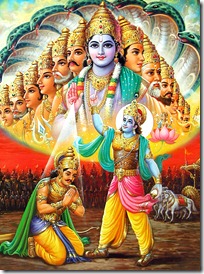 Since we have this tendency already, Krishna shows us that He is the greatest of the greatest. In terms of a collection of matter, nothing can be greater than the virat-rupa. “Why are only the asuras enamored by the universal form? Is there another perspective?” Krishna’s supremacy travels in both directions, the large and the small. The deluded consciousness that doesn’t see the difference between spirit and matter only thinks of greatness in terms of abundance, but the devotee knows that Krishna can be smaller than the smallest as well. While He is the virat-rupa, He is also the Supersoul within every creature. The tiny ant and the large elephant both have Krishna residing within them. Moreover, the fragments of spirit that emanate from Krishna are also infinitesimally small in size and yet can do great things on their own.
Since we have this tendency already, Krishna shows us that He is the greatest of the greatest. In terms of a collection of matter, nothing can be greater than the virat-rupa. “Why are only the asuras enamored by the universal form? Is there another perspective?” Krishna’s supremacy travels in both directions, the large and the small. The deluded consciousness that doesn’t see the difference between spirit and matter only thinks of greatness in terms of abundance, but the devotee knows that Krishna can be smaller than the smallest as well. While He is the virat-rupa, He is also the Supersoul within every creature. The tiny ant and the large elephant both have Krishna residing within them. Moreover, the fragments of spirit that emanate from Krishna are also infinitesimally small in size and yet can do great things on their own.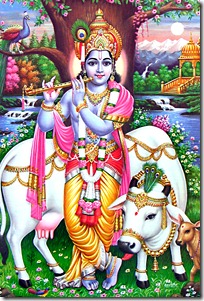 The charlatan posing to be God can be exposed just from their claim. Nevertheless, if others require more proof they can insist on seeing the virat-rupa. If you really are God, you should be able to show everything, the entire universe of stuff, to any person. If not, you are just a pretender, a cheater who exploits the valuable gem of Vedic wisdom for your own benefit. Krishna gives the transcendental wisdom of the Gita and the accompanying discipline of bhakti-yoga for the benefit of the worthy recipients, knowing full well that the soul is happiest when engaged in divine service. The implementation of that discipline is fine tuned through the association of the saints, and the ultimate arbiter of success or failure is Shri Krishna Himself, who looks at sincerity more than ability. To let Him know that we’re serious about making the most out of the rare human birth, we can chant the holy names, “
The charlatan posing to be God can be exposed just from their claim. Nevertheless, if others require more proof they can insist on seeing the virat-rupa. If you really are God, you should be able to show everything, the entire universe of stuff, to any person. If not, you are just a pretender, a cheater who exploits the valuable gem of Vedic wisdom for your own benefit. Krishna gives the transcendental wisdom of the Gita and the accompanying discipline of bhakti-yoga for the benefit of the worthy recipients, knowing full well that the soul is happiest when engaged in divine service. The implementation of that discipline is fine tuned through the association of the saints, and the ultimate arbiter of success or failure is Shri Krishna Himself, who looks at sincerity more than ability. To let Him know that we’re serious about making the most out of the rare human birth, we can chant the holy names, “